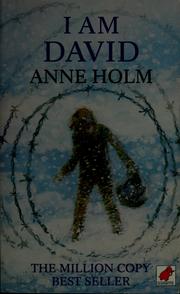I am David by Anne Holm, translated from the Danish by
L.W. Kingsland (Puffin, 1969; first published in Denmark, 1963)
8 chapters;
153 pages
Subjects:
Denmark, Italy, Eastern Europe, concentration camps, Cold War, dogs, fable, intermediate
fiction (Year 6-8)
Synopsis
This entry might be a bit
of a cheat, but it is included in all sincerity, even if under slightly false pretences.
I am David made a strong impression on me when I read it as a child. It’s one of the many classic Puffin
books discovered and published by their marvellous editor Kaye Webb.
Recently I re-read it
in preparation for a workshop I was holding on Writing about war for children,
and discovered that what I thought I knew about it was quite wrong. I
thought it was a book about a Jewish boy escaping from a concentration camp in
World War Two (a bit like The boy in the
striped pyjamas, but with a happier ending.) Turns out that’s not true at
all.
The clue is on pg 50 (in
my edition). Because David has grown up in the camp, he has no idea about
geography or anything else in the outside world, and he’s trying to work out
which countries are safe. His definition of a safe country is one with a king
or queen, and when he asks someone about England, the answer given is that “at the
moment there was a queen because the last king had had no sons, only
daughters.” So the book must be set after 1953 (when Queen Elizabeth came to
the throne) and it’s an Eastern Europe / Cold War / Communism story, not a
World War Two story at all.
Or is it? This article points out that David
is 12 in the story, so it's possible that he could have been born during World War Two.
There are some unlikely coincidences in the plot, especially towards the end, but I think this
ambiguity is partly why it has stayed in my memory. It is quite a haunting
book.
The book cover above
is my own copy, but there are a number of other editions with different covers.

Reviews:
This review on The bookbag calls David "an introspective, deep child" who "observes constantly and learns quickly and ... has his own, strong sense of what is right and what is wrong."
Another review on Reading matters comments that “the book is
not set in a real time or place. Although the circumstances seem real enough,
David's background is a synthesis of all the terrible persecution that happened
during the Second World War and the subsequent years of cold war communism.
This helps to make David a very powerful and pure figure. I don't think he is
particularly real. Anne Holm uses him as a blank canvas on which can be drawn
the first experiences of life - beauty, knowledge, trust, religion, love,
everything.”
It’s a
classic, there are masses of reviews and reading guides online. Don’t get
bogged down in them. Just read the book for yourself.
About the author
For such a
famous book, I couldn’t find much info on the author.
According to this obituary in the Independent, Anne Lise Elfe was born in Aal, Jutland, on 10 September 1922. She married Johan Holm in 1949 and they had one son. She died on 27 December 1998.
The writer of the obituary describes the book as "a landmark in bringing to children's attention the existence of a world of political evil and the misery this causes. Some doubted the need for revealing such harsh truths at an early stage, but the thousands of children who read the book often sent letters of thanks to the author. Sometimes they wrote directly to the fictional David as well."
I found this very interesting as it echoed the issues we were discussing in the workshop, to do with "how much” to tell children about war.
In the book, David himself says, “I am glad I
told Maria that evil exists. I don’t want her to be afraid, but it’s something
you have to know about. Can’t you understand that children have a right to know
everything that’s true?”
Other books you might like:
The silver sword by Ian Serraillier (1956) is also about children wandering through post-war Europe, trying to reach a safe country (in this case, Switzerland), although these children do have each other and aren't as completely alone as David.
Number the stars by Lois Lowry is set in Denmark (where David is told to head to) in World War Two and celebrates the bravery and compassion of the Danish people.
Number the stars by Lois Lowry is set in Denmark (where David is told to head to) in World War Two and celebrates the bravery and compassion of the Danish people.
Things I didn’t know
That this book which I loved as a child isn't about World War Two at all!


No comments:
Post a Comment